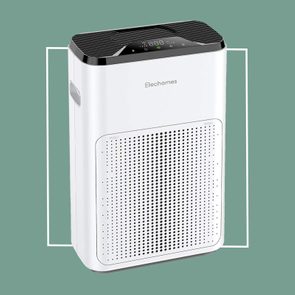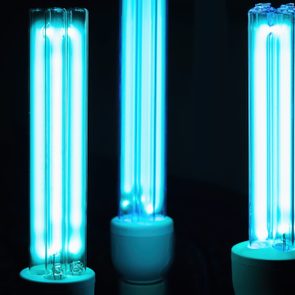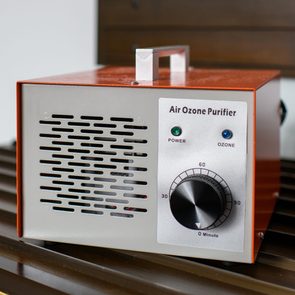The 8 Best Air Purifiers for Viruses
Updated: Mar. 09, 2021
Capture and kill airborne bacteria and viruses in your home with these portable air purifiers that meet experts' standards.
Our editors and experts handpick every product we feature. We may earn a commission from your purchases.
Using an air purifier to filter out viruses
The Covid-19 pandemic has caused us to rethink the safety of the air we breathe on a daily basis. The airborne illness travels from person to person through respiratory droplets released when a person coughs, sneezes, talks, or just breathes. It can even linger in the air for several hours. (Here’s how to stop coronavirus from spreading at home.)
The air-quality concerns surrounding Covid-19 have led to an uptick in purchases of air purifiers. In fact, the global air purifier market has seen a 9 percent increase in growth since 2015 and is expected to reach an annual growth rate of 10.8 percent by 2023, according to a report from The Business Research Company.
This is good news, not only for those in the air purifier business but for consumers who are living in homes with cleaner air. With a booming market comes a greater choice of air purifiers.
(Here are some allergist-approved air purifiers.)
How does an air purifier work?
An air purifier is a portable appliance invented to clean the air in a person’s home by eliminating impurities such as dust, smoke, pet dander, and odors, explains Niket Sonpal, MD, assistant professor of clinical medicine at Touro College of Osteopathic Medicine in New York City. “Air purifiers are typically composed of one or more filters paired with a fan that draws in [unclean air] and then circulates purified air,” he says. “As the air navigates through the various layers of filters, particles and irritants are captured and removed from the air that is being emitted into the room.”
(These are the people who need an air purifier.)
The materials used to create these filters vary among brands and purifier types but tend to include mesh, paper, and fiberglass. Most of these materials require frequent replacements. Air purifier filters are typically replaced every six to 12 months, though some last as long as two years.
(Here’s what to know about indoor air pollution.)
Do you need an air purifier?
The U.S. Environmental Protection Agency (EPA) estimates that indoor air can have as much as five times the level of pollution as outside air. That’s concerning when you consider how much time most of us spent indoors even before Covid-19-related lockdowns.
When you factor in that humans take in between 17,280 and 23,040 breaths per day (according to the EPA), it’s clear everyone could benefit from cleaner air.
It is worth noting, however, that air purifiers alone cannot prevent the spread of the coronavirus. While they may be able to clean the air in your home more efficiently, some virus particles may be smaller than the 0.3 microns that most air purifiers are able to capture. For this reason, it’s still paramount that you follow CDC guidelines to properly protect yourself from Covid-19.
(Here are your virus questions answered.)
What to look for in an air purifier for viruses
HEPA filter
Make sure the air purifier you purchase contains a HEPA (aka high-efficiency particulate air) filter, which is most effective in trapping particles, especially viruses, says Dr. Sonpal. HEPA filters work by mechanically filtering the air through a fine mesh material that captures harmful air particles and filters them out of the room.
“Those that contain HEPA filters are known for their ability to remove 99.97 percent of particles as small as 0.3 microns,” says Dr. Sonpal. “They can remove bigger pollutants as well, such as dust, pollen, and spores, if they are airborne.”
The efficiency of a HEPA air filter depends on the various specifications of the air purifier using it, says Clifford Bassett, MD, founder and medical director of Allergy and Asthma Care of New York and author of The New Allergy Solution.
“Actual performance can also depend on how frequently the HEPA filter is changed and how airtight the filter frame is,” he says. “Any gaps will allow mold spores through.”
Size
Not every air purifier will work in your space. The one you buy should specifically cover the size of the room in which you’ll be using it, says Dr. Sonpal. This is known as a clean air delivery rate (CADR) rating. Most air purifiers will describe the square footage that they are capable of covering. Naturally, larger spaces will use larger (and more expensive) air purifiers.
Filter replacements
Dr. Sonpal recommends looking into the cost of replacing the filters of an air purifier before you purchase one, as this is a cost that you will need to keep in mind in order to maintain the efficacy of your device. How much replacement filters cost will depend on the material and type of purifier.
UV light
A UV light, combined with a HEPA filter, will be your best bet for killing bacteria and viruses, according to Sunitha D. Posina, MD, a New York-based internist. Ultraviolet-C rays (UVC) destroy the nucleic acid material that bacteria and viruses require to function.
“UVC has been shown to kill Covid-19 and other coronaviruses on surfaces, in liquids, and in the air,” says Dr. Posina. But opt for devices that use “far-UVC,” she says. Other versions can have hazardous effects; for instance, they can emit ozone that may irriate the lungs and can harm the eyes if you look at the light.
(Here’s what you need to know about UV air purifiers.)
Certifications
You want to make sure that your air purifier is certified, ideally by Energy Star, which ensures that a product meets strict energy performance standards set out by the EPA.
Another certification worth considering is from the Association of Home Appliance Manufacturers (AHAM), which independently tests products, provides the CADR of each, and advises on the most suitable size of room for that purifier. It’s worth noting, however, that there is no current CADR rating for mold as there is for allergens like pollen, smoke, and dust.
The best air purifiers for viruses
These air purifiers are best suited for getting rid of virus particles in your home. (Also, here’s what to know about ozone air purifiers.)

Dyson Pure Hot + Cool Air Purifier
$650
With automatic sensing that instantly detects air pollution, including viruses, bacteria, volatile organic compounds (VOCs, gases present in indoor air), pet dander, smoke, mold spores, and more, the Dyson Pur Hot + Cool air purifier is hard to beat. It starts purifying within seconds, and filter replacement is simple.
The purifier is in high demand because, as Dr. Sonpal notes, it goes beyond air purification to heat and cool the room, too. Though pricier than most air purifiers, it connects to Wi-Fi, so you can control it via an app, and works with Alexa and Siri.

Winix 5500-2 Air Purifier
$160
If you’re looking for a top-notch air purifier that won’t cost you a fortune, this Winix air purifier is great choice. It utilizes a true HEPA filter. “It’s not the most technologically advanced model, but it has many practical functions, such as a sleep mode, status lights, smart sensors, and a timer,” says Dr. Sonpal. It also has a CADR rating for a 360-square-foot sized room, so it’s good for medium and large spaces.
(These are the household items poisoning your air.)

Germ Guardian AC4825E Air Purifier
$85
Here’s another air purifier that’s on the bargain list, though it’s on the small size, with a cleaning capacity of just 167 square feet. If you choose to use this Germ Guardian air purifier in a small room, however, it will HEPA-filter the air in your room from the usual allergens (dust, pollen, etc.) plus airborne viruses such as influenza, staph, and rhinovirus. It also reduces odors, thanks to its charcoal filter.

LG PuriCare 360-Degree Air Purifier
$1,300
If you’re seeking an air purifier that is “smart” in every possible way, this model from LG is about as high-tech as it gets. It’s definitely one of the more expensive options on the market, but its laundry list of cool features stands up to its price tag. “The LG PuriCare 360-Degree Air Purifier has tech features that permit the user to see the concentrations of particles, check the filter status, and all of these can be monitored from your smartphone via an app,” says Dr. Sonpal. “Aside from the tech components, this product has a high-caliber filtration system due to its ultra-fine pre-filter, a genuine HEPA filter, and an absorbent filter.”
(This is how your house is making you sick.)

The RxAir
$899
With testing from the Food and Drug Administration, third-party analysis, safety studies, and effective UVC light in a safe kill chamber design, RxAir’s air purifier is one virus particles don’t want to mess with. It rids the air of allergens including dust, mold, fungi, viruses like the coronavirus and the flu, and bacteria such as tuberculosis (TB) and MRSA.

Sharp IoT Plasmacluster Ion Air Purifier
$430
If you’re looking for a HEPA air purifier that can cover a large space—a room as large as 502 square feet—this is a great option from Sharp. It cleans the air of certain viruses, bacteria, mold, fungi, odors, pollen, dust, and smoke. It’s easy to use, too: You can control the air purifier via an app (which sends alerts when it’s time to replace the filter) or with your voice and Amazon Alexa.
(Here’s how to cope with allergy symptoms while you work.)

Mila Air Purifier
$299
If you have little ones in your home, you’ll be relieved to know that this Mila air purifier was founded by three dads who set out to provide clean air for their children. It is a cleaning powerhouse with a high-performance HEPA and impressive CADR that can handle rooms up to 1,000 square feet, filtering out 95.7 percent of airborne viruses in under 30 minutes. You can connect your air purifier to a smartphone app so you can control the system from everywhere. Its chic appearance doesn’t hurt either.

Molekule Air Purifier
$799
Instead of a HEPA filter, this air purifier from Molekule uses what’s known as photoelectrochemical oxidation (PECO) technology to rid the air of allergens. The company claims its PECO process destroys pollutants 1,000 times smaller than those a HEPA filter can catch. This may be helpful for ridding the air of bacteria, gases, VOCs, viruses, and mold, which may be smaller than dust or pet dander particles. This purifier tends to be on the quiet side, which is a major plus for many consumers, especially parents.
Next, take a look at these NASA-approved air-cleaning plants to detoxify your home.
















